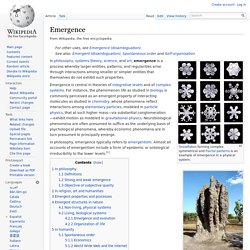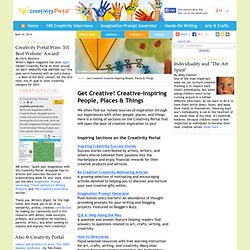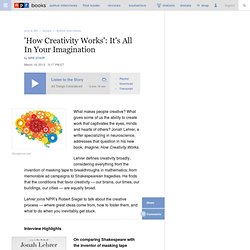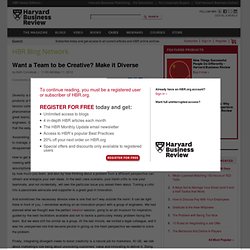Emergence
 In philosophy, systems theory, science, and art, emergence is a process whereby larger entities, patterns, and regularities arise through interactions among smaller or simpler entities that themselves do not exhibit such properties. Emergence is central in theories of integrative levels and of complex systems. For instance, the phenomenon life as studied in biology is commonly perceived as an emergent property of interacting molecules as studied in chemistry, whose phenomena reflect interactions among elementary particles, modeled in particle physics, that at such higher mass—via substantial conglomeration—exhibit motion as modeled in gravitational physics. In philosophy, emergence typically refers to emergentism. In philosophy[edit] Main article: Emergentism In philosophy, emergence is often understood to be a claim about the etiology of a system's properties. Definitions[edit] This idea of emergence has been around since at least the time of Aristotle. Strong and weak emergence[edit]
In philosophy, systems theory, science, and art, emergence is a process whereby larger entities, patterns, and regularities arise through interactions among smaller or simpler entities that themselves do not exhibit such properties. Emergence is central in theories of integrative levels and of complex systems. For instance, the phenomenon life as studied in biology is commonly perceived as an emergent property of interacting molecules as studied in chemistry, whose phenomena reflect interactions among elementary particles, modeled in particle physics, that at such higher mass—via substantial conglomeration—exhibit motion as modeled in gravitational physics. In philosophy, emergence typically refers to emergentism. In philosophy[edit] Main article: Emergentism In philosophy, emergence is often understood to be a claim about the etiology of a system's properties. Definitions[edit] This idea of emergence has been around since at least the time of Aristotle. Strong and weak emergence[edit]
Hey there. My name is Maria Popova and I’m a reader, writer, interestingness hunter-gatherer, and curious mind at large. I’ve previously written for Wired UK, The Atlantic, The New York Times, and Harvard’s Nieman Journalism Lab, among others, and am an MIT Futures of Entertainment Fellow. Maria Popova. Brain Pickings is my one-woman labor of love — a subjective lens on what matters in the world and why. Founded in 2006 as a weekly email that went out to seven friends and eventually brought online, the site was included in the Library of Congress permanent web archive in 2012. Here’s a little bit about my seven most important learnings from the journey so far. I think of it as LEGOs — if the bricks we have are of only one shape, size, and color, we can build things, but there’s a limit to how imaginative and interesting they will be. Please enjoy. For more on the ethos behind this labor of love, here is my On Being conversation with the wonderful and generous Krista Tippett:
about

Aaron DeOliveira alerts us to a wonderful presentation by writer/artist/poet Austin Kleon called Steal Like an Artist. It's a little less than 8 minutes, but worth watching: There's a lot in there that will sound familiar if you're a regular reader, but it goes over the simple fact that content creators always build on the works of those they come across, whether on purpose or not. There were two lines that really caught my attention. The first was this one: You are a mashup of what you let into your life. We keep hearing from people who seem to think that the only "real" art is art that is wholly original. Imitation is not flattery. I'm not sure I agree with that statement, but it made me think. I'd never heard of Kleon before, but it appears that this presentation is a short version of a longer talk that he's actually turning into a book.
You Are A Mashup Of What You Let Into Your Life

by Maria Popova The genealogy of ideas, why everything is a remix, or what T.S. Eliot can teach us about creativity. UPDATE: Kleon’s Steal Like an Artist synthesizes his ideas on creativity and is absolutely fantastic. Austin Kleon is positively one of the most interesting people on the Internet. In this excellent talk from The Economist‘s Human Potential Summit, titled Steal Like an Artist, Kleon makes an articulate and compelling case for combinatorial creativity and the role of remix in the idea economy. Kleon, who has clearly seen Kirby Ferguson’s excellent Everything is a Remix, echoes the central premise of my own recent talk on networked knowledge and combinatorial creativity: Nothing is completely original. Amen. And even more in the vein of the Brain Pickings ethos, reminiscent of this favorite quote by iconic designer Paula Scher: We can pick our teachers and we can pick our friends and we can pick the books we read and the music we listen to and the movies we see, etcetera.
Austin Kleon on Cultivating Creativity in the Digital Age

Creativity Processes, Creative Thinking and Lateral Thinking from MindTools
© iStockphoto/pavlen The tools in this section can help you to become more creative. They are designed to help you devise creative and imaginative solutions to problems, and help you to spot opportunities that you might otherwise miss. Before you continue, it is important to understand what we mean by creativity, as there are two completely different types. The first is technical creativity, where people create new theories, technologies or ideas. This is the type of creativity we discuss here. Many of the techniques in this chapter have been used by great thinkers to drive their creativity. Approaches to Creativity There are two main strands to technical creativity: programmed thinking and lateral thinking. The other main strand uses 'Lateral Thinking'. Programmed Thinking and Lateral Thinking Lateral thinking recognizes that our brains are pattern recognition systems, and that they do not function like computers. Unfortunately, we get stuck in our patterns. Taking the Best of Each...


Copy and Share Documents with your Cell Phone Camera
Conrad Hametner is passionate about globalizing technology and building forward thinking companies to address consumer and community needs. He has been called an “all-around executive athlete,” experienced in Marketing, Business Development and Operations. Conrad is also known by many foreign companies as “our man in the US” for his ability to launch technologies into US markets. He honed his business skills while working for technology companies with roots in Asia, Europe and the United States. Conrad led the US effort to build the French-based Qipit service, recognized by Red Herring as a top 100 "Most Promising" European private technology companies to drive the future of technology. Conrad served a vital role in building Dwango Wireless, the first publicly traded pure play mobile media publisher in the US. Dwango achieved an industry first: the first application capable of in-app billing, laying the groundwork for a viable freemium business model in the mobile industry.

Get Creative! Creative-Inspiring People, Places & Things on Creativity-Portal.com
Home : Get Creative! Creative-Inspiring People, Places & Things We often find our richest sources of inspiration through our experiences with other people, places, and things. Here is a listing of sections on the Creativity Portal that will open the door of creative inspiration to you! Inspiring Sections on the Creativity Portal Inspiring Creativity Success Stories Success stories contributed by artists, writers, and others who've followed their passions into the marketplace and enjoy financial rewards for their creative products and services. Be Creative! Imagination Prompt Generator Push-button story starters! Q & A: Help Along the Way A question and answer feature helping readers find answers to questions related to art, crafts, writing, and creativity. How-to Directories Hand-selected resources with free learning instruction for art, crafts, writing, and creativity. Art and Craft Articles, Lessons, and Tutorials "How to" features within the Creativity Portal. Be Creative!
Creativity Portal® - Creativity Coaching, Inspiration, Muses, Writing & Art Prompts, Team Creativity
Wednesday, March 30th, 2011 Buy the book: Amazon | B&N | More… Here’s what a few folks have said about it: “Brilliant and real and true.” Read an excerpt below… Tags: steal like an artist
How To Steal Like An Artist by Austin Kleon

iStockphoto.com What makes people creative? What gives some of us the ability to create work that captivates the eyes, minds and hearts of others? Lehrer defines creativity broadly, considering everything from the invention of masking tape to breakthroughs in mathematics; from memorable ad campaigns to Shakespearean tragedies. Lehrer joins NPR's Robert Siegel to talk about the creative process — where great ideas come from, how to foster them, and what to do when you inevitably get stuck. Interview Highlights On comparing Shakespeare with the inventor of masking tape "I think we absolutely can lump them all together. "... On how Steve Jobs redesigned Pixar studios to maximize collaboration and creativity "The original design for the Pixar studios consisted of three separate buildings, where they'd put the computer scientists in one building, and the animators in a second building and the third building would contain everybody else: the directors, the editors and so on. " ...
'How Creativity Works': It's All In Your Imagination

 by Beth Comstock | 11:05 AM May 11, 2012 Diversity is the crucial element for group creativity. Innovation teams tasked with creating new products or technologies or iterating existing ones need tension to produce breakthroughs, and tension comes from diverse points of view. This is the opposite of groupthink, the creativity-killing phenomenon of too much agreement and too similar perspectives that often paralyzes otherwise great teams. We’ve all been on these teams. Assembling and managing diverse teams is hard work. How to get started? And sometimes the necessary diverse view is one that isn’t way outside the norm: it can be right there in front of you. Finally, integrating divergent views to boost creativity is a natural job for marketers.
by Beth Comstock | 11:05 AM May 11, 2012 Diversity is the crucial element for group creativity. Innovation teams tasked with creating new products or technologies or iterating existing ones need tension to produce breakthroughs, and tension comes from diverse points of view. This is the opposite of groupthink, the creativity-killing phenomenon of too much agreement and too similar perspectives that often paralyzes otherwise great teams. We’ve all been on these teams. Assembling and managing diverse teams is hard work. How to get started? And sometimes the necessary diverse view is one that isn’t way outside the norm: it can be right there in front of you. Finally, integrating divergent views to boost creativity is a natural job for marketers.
Want a Team to be Creative? Make it Diverse - Beth Comstock
by Kyle Wiens | 8:54 AM May 18, 2012 Polymath is one of those words more likely to show up on the SAT than in everyday conversation. But the reason we don’t use the word much these days has less to do with vocabulary than it has to do with practicality: there aren’t a lot of polymaths around anymore. In case you don’t have your pocket dictionary handy, a polymath is a person with a wide range of knowledge or learning. Still, while we admire the select “geniuses” that can do it all, we tend to disparage the regular folk who attempt to spread their knowledge around a little. But why? “It’s the stupidest thing I’ve ever heard,” Angelou said to the Smithsonian. What’s more, in the digital age, learning has really never been easier — and not just for the “geniuses” that walk among us. Information is everywhere, and it’s often free. iTunesU gives your everyday-Joe an opportunity to get a free, virtual Ivy-league education from his couch. So, why aren’t there more of us polymaths?
In Defense of Polymaths - Kyle Wiens
10 Bizarre Facts about Famous Creative Geniuses
Creativity Toolbox
Get Creative! Creative-Inspiring People, Places & Things on Creativity-Portal.com
Creative Techniques
This A to Z of Creativity and Innovation Techniques, provides an introduction to a range of tools and techniques for both idea generation (Creativity) and converting those ideas into reality (Innovation). Like most tools these techniques all have their good and bad points. I like to think of these creativity and innovation techniques as tools in a toolbox in much the same way as my toolbox at home for DIY. It has a saw, spanner, hammer, knife and all sorts of other things in it, they are all very useful, but you have to pick the right tool (creativity / Innovation technique) for each job. This site will try and provide a little guidance along with each tool to let you know whether it's best used for cutting paper or putting in nails. For the future, the aim is to also have sub-categories which will identify Techniques for; Problem Definition - including problem analysis, redifinition, and all aspects associated with defining the problem clearly. Subcategories
A Model of The Creative Process
Created in collaboration with Jack Chung, Shelley Evenson, and Paul Pangaro. The creative process is not just iterative; it’s also recursive. It plays out “in the large” and “in the small”—in defining the broadest goals and concepts and refining the smallest details. It branches like a tree, and each choice has ramifications, which may not be known in advance. Recursion also suggests a procedure that “calls” or includes itself. The creative process involves many conversations—about goals and actions to achieve them—conversations with co-creators and colleagues, conversations with oneself. See also our How do you design? Download PDF
Top Ten Argument Mapping Tutorials. Six online tutorials in argument mapping, a core requirement for advanced critical thinking.The Skeptic's Dictionary - over 400 definitions and essays. The Fallacy Files by Gary Curtis. Best website on fallacies. What is critical thinking? Nobody said it better than Francis Bacon, back in 1605: For myself, I found that I was fitted for nothing so well as for the study of Truth; as having a mind nimble and versatile enough to catch the resemblances of things … and at the same time steady enough to fix and distinguish their subtler differences; as being gifted by nature with desire to seek, patience to doubt, fondness to meditate, slowness to assert, readiness to consider, carefulness to dispose and set in order; and as being a man that neither affects what is new nor admires what is old, and that hates every kind of imposture. A shorter version is the art of being right. More definitions... Program for Critical Thinking Program for better decision making
Critical Thinking On The Web
What's the Latest Development? By developing computer simulations of neural networks that evolved over 50,000 generations, scientists at Trinity University have concluded that intelligence is an evolutionary byproduct of social teamwork. Each neural network, or 'brain', took part in two social dilemmas in which "two players must choose between cooperation and defection during repeated rounds. Upon completion of either game, each 'brain' produced 'offspring' with other 'brains' that made more advantageous choices during the games. ... After 50,000 generations, the model showed that as cooperation increased, so did the intelligence of the programmed brains." What's the Big Idea? Evolutionary biologists have long been puzzled by the high levels of intelligence that are seen in humans and other animals like primates, dolphins and birds. Photo credit: shutterstock.com
What Is Intelligence? Just a Byproduct of Cooperation. | IdeaFeed
How to overcome creative block: 20 brilliant tips | Design
13 Desktop Wallpapers To Kickstart Your Creativity
The Simple Truth About Happiness
Creativity (public) on Springpad
Creativity across the life-span: A systems view
Why Everyone From Beethoven, Goethe, Dickens, Darwin To Steve Jobs Took Long Walks and Why You Should Too
Fostering creativity - Research summaries
Robert Fisher Teaching Thinking homepage
To encourage creativity, Mr Gove, you must first understand what it is | Ken Robinson
Creativity Essay - What is creativity? Creativity explained by Silvia Hartmann
75 Creativity Quotes
Polymath: Jack of All Trades, Master of Insight
The Ideal Future Problem Solving Team
DreamWorks’ New Tablet Entertains--And Trains--The Next Generation Of Animators
Cultivating Creativity
Mathematical Creativity and School Mathematics
Creative Math Problem Solving
What is Creativity? | Creativity at Work
Quote
Summary

 In philosophy, systems theory, science, and art, emergence is a process whereby larger entities, patterns, and regularities arise through interactions among smaller or simpler entities that themselves do not exhibit such properties. Emergence is central in theories of integrative levels and of complex systems. For instance, the phenomenon life as studied in biology is commonly perceived as an emergent property of interacting molecules as studied in chemistry, whose phenomena reflect interactions among elementary particles, modeled in particle physics, that at such higher mass—via substantial conglomeration—exhibit motion as modeled in gravitational physics. In philosophy, emergence typically refers to emergentism. In philosophy[edit] Main article: Emergentism In philosophy, emergence is often understood to be a claim about the etiology of a system's properties. Definitions[edit] This idea of emergence has been around since at least the time of Aristotle. Strong and weak emergence[edit]
In philosophy, systems theory, science, and art, emergence is a process whereby larger entities, patterns, and regularities arise through interactions among smaller or simpler entities that themselves do not exhibit such properties. Emergence is central in theories of integrative levels and of complex systems. For instance, the phenomenon life as studied in biology is commonly perceived as an emergent property of interacting molecules as studied in chemistry, whose phenomena reflect interactions among elementary particles, modeled in particle physics, that at such higher mass—via substantial conglomeration—exhibit motion as modeled in gravitational physics. In philosophy, emergence typically refers to emergentism. In philosophy[edit] Main article: Emergentism In philosophy, emergence is often understood to be a claim about the etiology of a system's properties. Definitions[edit] This idea of emergence has been around since at least the time of Aristotle. Strong and weak emergence[edit]




 Copy and Share Documents with your Cell Phone Camera
Conrad Hametner is passionate about globalizing technology and building forward thinking companies to address consumer and community needs. He has been called an “all-around executive athlete,” experienced in Marketing, Business Development and Operations. Conrad is also known by many foreign companies as “our man in the US” for his ability to launch technologies into US markets. He honed his business skills while working for technology companies with roots in Asia, Europe and the United States. Conrad led the US effort to build the French-based Qipit service, recognized by Red Herring as a top 100 "Most Promising" European private technology companies to drive the future of technology. Conrad served a vital role in building Dwango Wireless, the first publicly traded pure play mobile media publisher in the US. Dwango achieved an industry first: the first application capable of in-app billing, laying the groundwork for a viable freemium business model in the mobile industry.
Copy and Share Documents with your Cell Phone Camera
Conrad Hametner is passionate about globalizing technology and building forward thinking companies to address consumer and community needs. He has been called an “all-around executive athlete,” experienced in Marketing, Business Development and Operations. Conrad is also known by many foreign companies as “our man in the US” for his ability to launch technologies into US markets. He honed his business skills while working for technology companies with roots in Asia, Europe and the United States. Conrad led the US effort to build the French-based Qipit service, recognized by Red Herring as a top 100 "Most Promising" European private technology companies to drive the future of technology. Conrad served a vital role in building Dwango Wireless, the first publicly traded pure play mobile media publisher in the US. Dwango achieved an industry first: the first application capable of in-app billing, laying the groundwork for a viable freemium business model in the mobile industry.
 Get Creative! Creative-Inspiring People, Places & Things on Creativity-Portal.com
Home : Get Creative! Creative-Inspiring People, Places & Things We often find our richest sources of inspiration through our experiences with other people, places, and things. Here is a listing of sections on the Creativity Portal that will open the door of creative inspiration to you! Inspiring Sections on the Creativity Portal Inspiring Creativity Success Stories Success stories contributed by artists, writers, and others who've followed their passions into the marketplace and enjoy financial rewards for their creative products and services. Be Creative! Imagination Prompt Generator Push-button story starters! Q & A: Help Along the Way A question and answer feature helping readers find answers to questions related to art, crafts, writing, and creativity. How-to Directories Hand-selected resources with free learning instruction for art, crafts, writing, and creativity. Art and Craft Articles, Lessons, and Tutorials "How to" features within the Creativity Portal. Be Creative!
Get Creative! Creative-Inspiring People, Places & Things on Creativity-Portal.com
Home : Get Creative! Creative-Inspiring People, Places & Things We often find our richest sources of inspiration through our experiences with other people, places, and things. Here is a listing of sections on the Creativity Portal that will open the door of creative inspiration to you! Inspiring Sections on the Creativity Portal Inspiring Creativity Success Stories Success stories contributed by artists, writers, and others who've followed their passions into the marketplace and enjoy financial rewards for their creative products and services. Be Creative! Imagination Prompt Generator Push-button story starters! Q & A: Help Along the Way A question and answer feature helping readers find answers to questions related to art, crafts, writing, and creativity. How-to Directories Hand-selected resources with free learning instruction for art, crafts, writing, and creativity. Art and Craft Articles, Lessons, and Tutorials "How to" features within the Creativity Portal. Be Creative!


 by Beth Comstock | 11:05 AM May 11, 2012 Diversity is the crucial element for group creativity. Innovation teams tasked with creating new products or technologies or iterating existing ones need tension to produce breakthroughs, and tension comes from diverse points of view. This is the opposite of groupthink, the creativity-killing phenomenon of too much agreement and too similar perspectives that often paralyzes otherwise great teams. We’ve all been on these teams. Assembling and managing diverse teams is hard work. How to get started? And sometimes the necessary diverse view is one that isn’t way outside the norm: it can be right there in front of you. Finally, integrating divergent views to boost creativity is a natural job for marketers.
Want a Team to be Creative? Make it Diverse - Beth Comstock
by Beth Comstock | 11:05 AM May 11, 2012 Diversity is the crucial element for group creativity. Innovation teams tasked with creating new products or technologies or iterating existing ones need tension to produce breakthroughs, and tension comes from diverse points of view. This is the opposite of groupthink, the creativity-killing phenomenon of too much agreement and too similar perspectives that often paralyzes otherwise great teams. We’ve all been on these teams. Assembling and managing diverse teams is hard work. How to get started? And sometimes the necessary diverse view is one that isn’t way outside the norm: it can be right there in front of you. Finally, integrating divergent views to boost creativity is a natural job for marketers.
Want a Team to be Creative? Make it Diverse - Beth Comstock